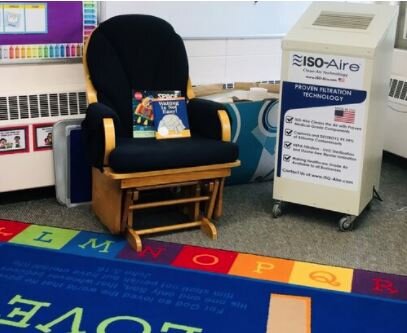How to Calculate Air Changes Per Hour to Achieve a Safe Classroom
Compared to the attention that outdoor air quality has received in the past two decades, indoor air quality (IAQ) has received little focus. However, during the COVID-19 pandemic, more of us are starting to care about the indoor air we breathe, particularly in schools.
Our ISO-Aire™ RSF300 air purifier was selected for this room at Loving Shepherd Early Learning Center based on recommended ACH guidelines, helping to keep the indoor air healthy and clean.
According to the Environmental Protection Agency (EPA), IAQ includes the air quality inside and around buildings and structures. IAQ can be lowered by the presence of volatile organic compounds (VOCs), airborne germs like bacteria and viruses, and carbon dioxide (CO2). With poor IAQ comes a slew of health conditions that may include irritation of the respiratory tract, dizziness, fatigue, asthma, or even as severe as cancer and neurological damage. All of these have been proven to have an impact on learning and school absenteeism.
Understanding what is good IAQ vs. bad IAQ requires a vast understanding of the ins and outs of air quality measurement and ideal goals to help prevent the health conditions mentioned above.
Why Do Air Changes Per Hour (ACH) Matter & How Do You Calculate ACH?
One important consideration for air quality is the number of air changes per hour. Air change per hour (ACH) is the number of times in an hour that ALL of the air in an indoor space is replaced with new air. Take a look at the following equation that can be helped to determine ACH provided by a particular purifier and size of room desired to be purified:
ACH = CFM of Filtration Device * 60 / cubic feet of room (length x width x height)
Let’s say your space is a classroom, and you want to not only protect your students and staff from COVID-19, but other indoor air pollutants as well. For schools, ASHRAE and the CDC recommend having a portable HEPA air purifier that provides a minimum of 2 ACH in an hour, with the goal of achieving the highest achievable ACH as possible.
Air Purifiers that Provide the ACH You Need
At ISO-Aire, we’ve kept the safety of those in schools at the forefront of our vision in developing the most elite and effective portable air purifiers. While presenting at a clean air technology seminar hosted by St. Paul College located in St. Paul, Minn., Albers explained: “We didn’t invent the HEPA filter, we didn’t invent the powerful fans, but we figured out a way to engineer the pieces together into a single package that’s easy to deploy, works well, and is sized to the right space. There are a lot of products out there saying they’ll clean the air, but when you calculate the CFM and air changes per hour (ACH), they’re too small. With our units, you’ll see there’s quite a difference.”
ISO-Aire offers up to 3 layers of air-purifying technology, with a HEPA filter, ozone-free bipolar ionization, and ultraviolet-C (UVC) germicidal lamps. Our units can be introduced as a portable, stand-alone unit or into the existing ductwork that can help school buildings with or without ductwork constraints to reach the air changes per hour that they are looking for, keeping everyone in the school safe and happy.
Contact our team of experts today at 651-265-0605 or email at info@iso-aire.com. We would be happy to assist you with calculating the ACH you need to safely protect your space.



